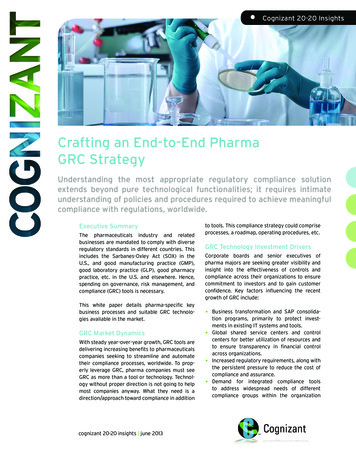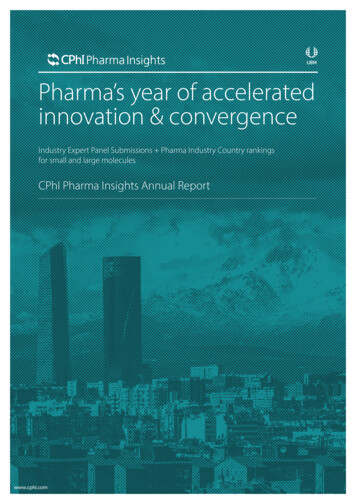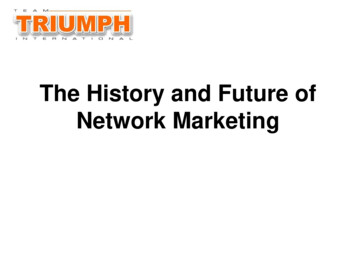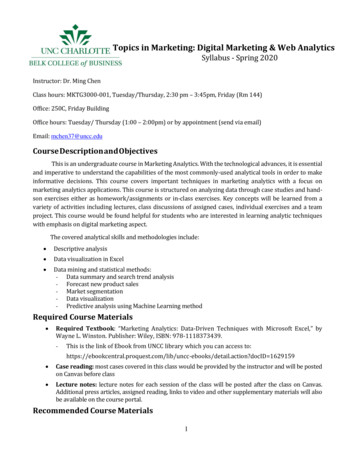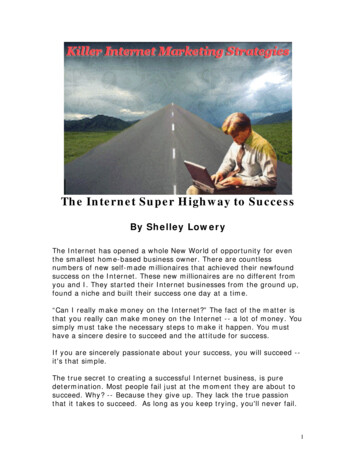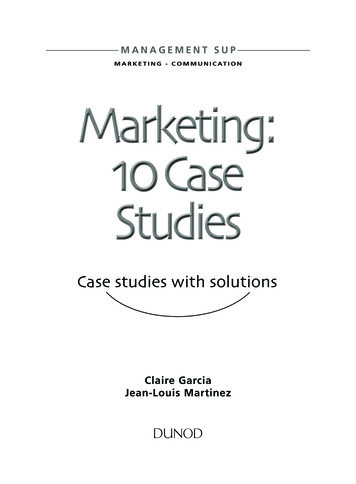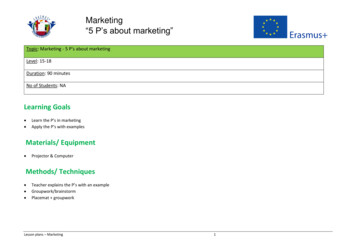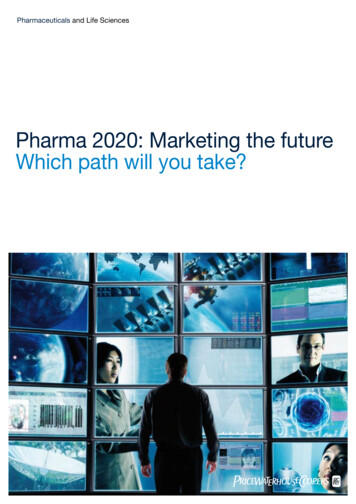
Transcription
Pharmaceuticals and Life SciencesPharma 2020: Marketing the futureWhich path will you take?
Table of contentsPrevious publications in this series include:PharmaceuticalsPharmaceuticals and Life SciencesPharma 2020: The visionWhich path will you take?*Pharma 2020: Virtual R&DWhich path will you take?*connectedthinkingPharma 2020: The vision #Published in June 2007 this paper highlights a number ofissues that will have a major bearing on the industry overthe next 11 years. The publication outlines the changes webelieve will best help pharmaceutical companies realise thepotential the future holds to enhance the value they provideto shareholders and society alike.Pharma 2020: Virtual R&D1This report published in June 2008 explores opportunitiesto improve the R&D process. It proposed that newtechnologies will enable the adoption of virtual R&D; andby operating in a more connected world the industry, incollaboration with researchers, governments, healthcarepayers and providers, can address the changing needs ofsociety more effectively.“Pharma 2020: Marketing the future” is the third in this series of papers on the future of the pharmaceutical industry published byPricewaterhouseCoopers. It discusses the key forces reshaping the pharmaceutical marketplace, including the growing power of healthcare payers,providers and patients, and the changes required to create a marketing and sales model that is fit for the 21st century. These changes will enablethe industry to market and sell its products more cost-effectively, to create new opportunities and to generate greater customer loyalty across thehealthcare spectrum.
Table of contentsIntroduction2What will the healthcare landscape look like in 2020?4Recognising the interdependence of the pharmaceutical andhealthcare value chains8Investing in the development of medicines the market wants to buy10Forming a web of alliances to offer supporting services12Developing a plan for marketing and selling specialist therapies13Creating a culture that is suitable for marketing specialist healthcare packages15Managing multi-country launches and live licensing18Adopting a much more flexible approach to pricing18Creating a marketing and sales function that is fit for the future19Conclusion22Pharma 2020: Marketing the future
IntroductionThe social, demographic and economiccontext in which the pharmaceuticalindustry (Pharma) operates is changingdramatically, as we noted in “Pharma2020: The vision”, the White PaperPricewaterhouseCoopers* published inJune 2007 (see sidebar, Seven majortrends reshaping the pharmaceuticalmarketplace).1 All these challengeshave major ramifications for the way inwhich Pharma markets and sells themedicines it develops – the subject onwhich we shall focus here.The industry has traditionally relied onaggressive marketing to promote itsproducts. One recent study estimatesthat, between 1996 and 2005, totalreal spending on pharmaceuticalpromotions rose from US 11.4 billionto US 29.9 billion in the US (the onlycountry for which expenditure on allmajor marketing and sales activitiesis available).2 Another study suggeststhat the true figure (including meetingsand e-promotions) is closer to US 57.5billion in real terms.3Seven major trends reshaping the pharmaceutical marketplaceThe pharmaceutical marketplace is changing dramatically, with huge implications for the industry as a whole. We have identifiedseven major socio-economic trends.The burden of chronic disease issoaring. The prevalence of chronicdiseases like diabetes is growingeverywhere. As greater longevity forcesmany countries to lift the retirement age,more people will still be working at thepoint at which these diseases start. Thesocial and economic value of treatmentsfor chronic diseases will rise accordingly,but Pharma will have to reduce itsprices and rely on volume sales of suchproducts because many countries willotherwise be unable to afford them.Healthcare policy-makers andpayers are increasingly mandatingor influencing what doctors canprescribe. As treatment protocolsreplace individual prescribing decisions,Pharma’s target audience is alsobecoming more consolidated and morepowerful, with profound implicationsfor its sales and marketing model.The industry will have to work muchharder for its dollars, collaborate withhealthcare payers and providers, andimprove patient compliance.Pay-for-performance is on the rise.A growing number of healthcare payersare measuring the pharmacoeconomicperformance of different medicines.Widespread adoption of electronicmedical records will give them theoutcomes data they need to determinebest medical practice, discontinueproducts that are more expensive or lesseffective than comparable therapies andpay for treatments based on the outcomesthey deliver. So Pharma will have to provethat its medicines really work, providevalue for money and are better thanalternative forms of intervention.The boundaries between differentforms of healthcare are blurring. Theprimary-care sector is expanding asclinical advances render previously fataldiseases chronic. The self-medicationsector is also increasing as moreprescription products are switched toover-the-counter status. The needsof patients are changing accordingly.Where treatment is migrating from thedoctor to ancillary care or self-care,patients will require more comprehensiveinformation. Where treatment ismigrating from the hospital to theprimary-care sector, patients will requirenew services such as home delivery.The markets of the developing world,where demand for medicines is likelyto grow most rapidly over the next 13years, are highly varied. Developingcountries have very different clinical andeconomic characteristics, healthcaresystems and attitudes towards theprotection of intellectual property. Anycompany that wants to serve thesemarkets successfully will therefore haveto devise strategies that are tailored totheir individual needs.Many governments are beginningto focus on prevention rather thantreatment, although they are not yetinvesting very much in pre-emptivemeasures. This change of emphasiswill enable Pharma to enter the realmof health management. But if it is to doso, it will have to rebuild its image, sincehealthcare professionals and patientswill not trust the industry to providesuch services unless they are sure it hastheir best interests at heart.The regulators are becoming morerisk-averse. The leading national andmultinational agencies have becomemuch more cautious about approvingtruly innovative medicines, in the wakeof problems with medicines like Vioxx.*‘PricewaterhouseCoopers’ refers to the network of member firms of PricewaterhouseCoopers International Limited, each of which is a separate andindependent legal entity.2PricewaterhouseCoopers
Much of this increase in spending hasgone on the expansion of the salesforce. However, many of the industry’sbiggest markets are now saturated withsales representatives, and its sellingtechniques are becoming increasinglyineffective (see sidebar, Too manycooks spoil the broth).4Hence the fact that returns on detailing(sales visits to doctors) have begunto decline in the developed world.Between 2004 and 2005, there was a23% drop in dollar growth per detail inthe US, although detailing still accountsfor more than half the market sharenew brands win during their first year oflife. The picture is rather more varied inWestern Europe, but detailing plays amuch smaller role in stimulating sales inthese countries.5Conversely, detailing is still veryimportant in many developingnations. In China, for example, nearlythree-quarters of the informationdoctors receive about new medicinescomes from meetings with salesrepresentatives and conferences.6 Buthere, too, resistance to “irresponsible”marketing practices is growing,7 and, inMay 2007, the member governments ofthe World Health Organisation passed aresolution to enact or enforce legislationbanning the “inaccurate, misleading orunethical promotion of medicines”.8Direct-to-consumer (DTC) advertising– the other big weapon in Pharma’smarketing artillery – has also failed todeliver all that the industry expected.Only two countries – the US and NewZealand – currently allow companiesto market their medicines directly toconsumers, although the EuropeanCommission is considering a proposalto lift the ban on direct communicationsthat provide “objective.non-Pharma 2020: Marketing the futureToo many cooks spoil the brothBetween 1996 and 2005, the number of US sales representatives nearly doubledto 100,000, although the number of practising physicians rose by just 26%. Themarket is getting very crowded in other countries, too. In a recent poll of Britishgeneral practitioners, respondents reported receiving an average of four visitsa month and five promotional mailings a week. Similarly, one Malaysian doctorparticipating in a study of promotional practices in emerging countries wasapproached by 16 multinationals and nine local generics companies within a fiveweek time span.The battle for market share has triggered considerable alarm. Some 20% of USand British doctors now refuse to see any sales representatives. The regulationsgoverning the behaviour of sales representatives are also getting tougher. VariousUS states have passed laws requiring pharmaceutical companies to report allgifts or payments to healthcare professionals exceeding 25, while Australia hasbanned pharmaceutical companies from providing doctors with personal gifts,entertainment or lavish hospitality.Several industry trade groups have likewise introduced new codes of practice– and they are actively enforcing the rules. The Prescription Medicines Code ofPractice Authority (PMCPA), which administers the code of practice laid down bythe Association of the British Pharmaceutical Industry, is one such instance. ThePMCPA “names and shames” the most serious offenders, by reprimanding thempublicly and publicising the violations they have committed in advertisements inthe medical and pharmaceutical press.promotional” information.9 AndPharma’s spending on DTC advertisingonly accounts for about US 5 billion,which is just 14% of its total marketingbudget.10 However, the jury is still out onjust what this expenditure provides.In the early days, the returns appearedto be substantial. Between 1999 and2000, sales of the 50 products thatwere most heavily advertised in theUS soared by 32%, compared withan average increase of 13.6%.11 Butmore recent research suggests thatDTC advertising has little, if any, longterm impact on demand. In one studypublished in the British Medical Journal,the researchers compared the uptakeof three medicines in two populations –English-speaking Canadians exposedto US advertising and French-speakingCanadians, who primarily watch Frenchlanguage media – over a five-yearperiod. They found that DTC advertisinghad no effect on sales of two of thethree products and that, although salesof the third spiked by more than 40%when the campaign began, the spikewas quite brief.12Much of the industry’s expenditureon DTC advertising may have beenpointless, but the damage to itsreputation is arguably a more seriousproblem. In January 2008, the US Houseof Representatives Committee on Energyand Commerce initiated an investigationinto the misleading and deceptiveadvertising of medicines, after severalparticularly flagrant abuses of the rules.133
Table of contentsTable 1: Big Pharma has been slashingits workforceCompanyPfizerAnnouncedJob Cuts10,000AstraZeneca7,600Merck & Co.7,200Bayer6,000Schering-Plough5,500Johnson & 2,500Wyeth1,200sanofi-aventisTotalSource: PricewaterhouseCoopers70053,300In short, aggressive marketing –whether it be to doctors or patients – isbecoming increasingly ineffective as ameans of stimulating demand for newtherapies and overcoming reluctance topay premium prices for products thatare deemed to offer only minor clinicalimprovements. Industry critics are alsobecoming increasingly vociferous intheir complaints that it is wasteful oreven unethical.Big Pharma has responded with variouscost-cutting measures. Pfizer set thepace in late 2006, when it said that itwould cut 20% of its US sales force.14Other companies rapidly followed suitand, by October 2008, the industryleaders had announced plans to shedanother 53,300 jobs, many of them inmarketing and sales (see Table 1).15They are now turning their attentionto developing countries like India,where 10 multinationals are reportedto be trimming the number of salesrepresentatives they employ.16However, both industry executives andcommentators recognise that the failingsof the current marketing and salesmodel cannot be addressed simply byreducing the size of the sales force;the problems go very much deeper.We believe that they stem from threeincorrect assumptions, namely that: Pharma alone determines the valueof its products Products alone create value; and4 The buying and selling of medicinesis based solely on technical data likesafety and efficacy, as distinct fromsubjective criteria like quality of life.We shall discuss the changes that haveinvalidated these assumptions in moredetail in the next chapter.What will the healthcarelandscape look like in2020?For many years, pharmaceuticalcompanies decided what their productswere worth, and priced them accordingly.But healthcare policy-makers, payersand patient groups are now playingan increasingly important role in thevaluation process – and this trend willaccelerate, as healthcare expenditureeverywhere continues to soar.The aging of the population, togetherwith dietary changes and moresedentary lifestyles, is driving up thedisease burden in both developedand developing countries.17 People’sexpectations are also rising as newtherapies for treating serious illnesseslike cancer reach the market. Theglobal healthcare bill has risencommensurately; between 2000 and2006, expenditure on healthcare asa percentage of gross domestic p
English-speaking Canadians exposed to US advertising and French-speaking Canadians, who primarily watch French-language media – over a five-year period. They found that DTC advertising had no effect on sales of two of the three products and that, although sales of the third spiked by more than 40% when the campaign began, the spike was quite brief.12 Much of the industry’s expenditure on .
